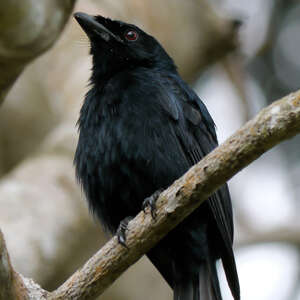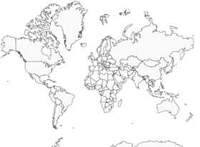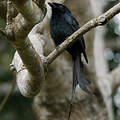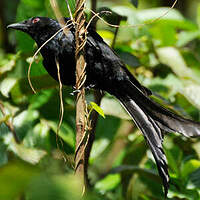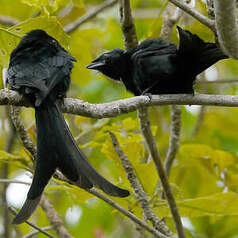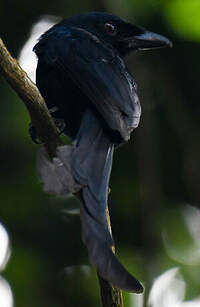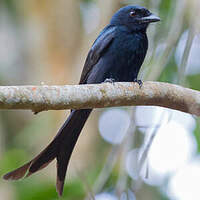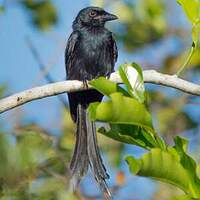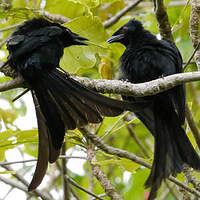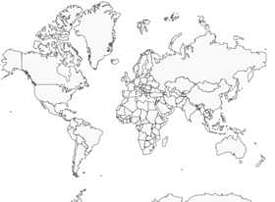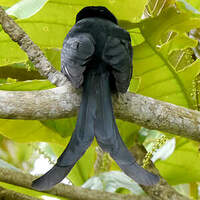Mayotte Drongo
Dicrurus waldenii - Drongo de Mayotte
Identification
The Mayotte Drongo is the largest drongo of the Comoros Islands, and it is endemic to Mayotte. Its body is completely black-charcoal with deep blue-green highlights. Its brick red iris stands out. Its very long tail (175 to 206 mm) and forked (58 to 90 mm) tail characterizes it. The distal extremity of the rectrices is strongly curved outwards. Its strong black beak, like its legs, is arched and has visible bristles. Both sexes are identical although the female is slightly smaller. Juveniles are rather dull, dark-black in colour. The tail is shorter and less forked. The underside is paler. It is known as Marimudu in Shimaorais, Lairuvi and Shibushi, dialects still used on the island of Mayotte.
Subspecific information monotypic species
Foreign names
- Drongo de Mayotte,
- Drongo de Mayotte,
- drongo-de-maiote,
- Mayottedrongo,
- Mayotte-i drongó,
- Mayottedrongo,
- Drongo di Mayotte,
- mayottedrongo,
- Mayottedrongo,
- drongo lužný,
- drongo mayottský,
- Mayottedrongo,
- mayottendrongo,
- drongo de l'illa Mayotte,
- dziwogon komorski,
- Майоттский дронго,
- マヨットオウチュウ,
- 马约特卷尾,
- mayottedrongo,
- 馬約特島卷尾,
Voice song and call
The Mayotte Drongo has a varied repertoire. When it hunts for insects, it emits light plitt plitt sounds. During mating season, couples perform remarkable duets with guttural sounds like squaa-aa-Kuchuk and very sharp, high tyok cries. The male calls with a chu-chi and the female responds with a chu; the male then follows with chit. The Mayotte Drongo is easily capable of imitating other species of birds.
Habitat
The Mayotte Drongo mainly inhabits natural forests on the island as well as moist secondary forests up to 350 meters above sea level.
Behaviour character trait
The Mayotte Drongo lives in pairs, it is a very territorial bird. The average size of its territory is 2 to 3 hectares in a natural and wet mixed forest and 9 to 10 hectares in the semi-wooded areas neighbouring agricultural fields.
During the reproductive period, it chases away any other Drongo present on its territory, but also any other presence: Mayotte Rousettes, Macaques, Sombre Martins and even any human presence. To mark their territory, the male and the female engage in long, repeated serenades during their nesting. They swing up and down, undulating their bodies while they fan out their long, forked tails which reveal the 8 tail feathers. The various calls during this dance echo in the deepest parts of the forest. These behaviours also strengthen the bond of the couple which will remain faithful for life.The Mayotte Drongo primarily hunts insects which it first spots from an lookout tree branch and later captures it in mid-air in the midst of vegetation at a height of 2 to 12 metres. It uses various flying techniques like those of Muscicapidae: it slides downwards, glides, and then zigzags amongst the vegetation. The rest of the time it searches for its food on tree trunks, branches, under the leaves and on the ground. It forcefully strikes its prey on a branch in order to remove the elytra.
Flight
Dietfeeding habits
Reproduction nesting
The nesting of the Mayotte Drongo coincides with the rainy season. They nest alone, building the nest on a horizontal dead branch or at the end of a fork, always in the middle of tall trees.
The height ranges from 5 to 18 metres, with an average height of 12 metres. The nest, built by both adults in some cases, in less than a week, is made of various sizes of twigs and old interwoven lianas. The female lays 1 to 3 cream-pink eggs, mostly with reddish spots at the top of her end. Laying begins in October and lasts until December. In case of failure in the first nesting, the couple will build a new nest in another spot for a replacement nesting. Incubation takes 19 to 21 days, done by both parents. The young stay in the nest between 17 and 22 days. The parents continue to feed the chicks for several weeks after they leave the nest and stay with them until the beginning of the next nesting. They take off in November-December for the first nesting and in February for the replacement nestings.Geographic range
Threats - protection
IUCN conservation status
concern
in the Wild
threatened
evaluated
In the past, little information was available on the Mayotte Drongo, indicating that it was critically endangered. Deforestation for agricultural and pastoral activities is the main threat to the bird, with 25% of Mayotte's forests having been lost between 1949 and 2002. The Mayotte Drongo has been relatively successful in adapting to such habitat change.
The influx of undocumented migrants sheltering in forests and fields, along with the recent population explosion on the island, further put pressure on this valued species. Already existing problems such as nest predation and abandonment are exacerbated by the introduction of new predators to the island.
The Mayotte Drongo needs to be monitored closely and used as a flagship species to spread awareness of the need to protect forests. Further research into the species would be beneficial; however, no such study plan has currently been put in place.
Sources of information
- IOC World Bird List (v15.1), Gill, F and D Donsker (Eds). 2025-12-07.
- Les Oiseaux de Mayotte, Clément Michel, Grissac Philippe, Rolland Robin
- Oiseaux des iles de l'océan Indien, Langrand Olivier, ian Sinclair
- HBW Alive,
- BirdLife International, BirdLife International
- Les oiseaux des espaces naturels remarquables de Mayotte, Rocamora Gérard, Said Soufou, Rolland Robin
- xeno-canto, Sharing bird sounds from around the world,
- Birds of the World, The Cornell Lab of Ornithology
- GEPOMAY,
Other sources of interest
 Specification sheet created on
26/07/2023 by Nathalie Santa Maria
Specification sheet created on
26/07/2023 by Nathalie Santa MariaTranslation by AI Oiseaux.net
© 1996-2025 Oiseaux.net
- Accipitriformes
- Aegotheliformes
- Anseriformes
- Apodiformes
- Apterygiformes
- Bucerotiformes
- Caprimulgiformes
- Cariamiformes
- Casuariiformes
- Charadriiformes
- Ciconiiformes
- Coliiformes
- Columbiformes
- Coraciiformes
- Cuculiformes
- Eurypygiformes
- Falconiformes
- Galliformes
- Gaviiformes
- Gruiformes
- Leptosomiformes
- Mesitornithiformes
- Musophagiformes
- Nyctibiiformes
- Opisthocomiformes
- Otidiformes
- Passeriformes
- Pelecaniformes
- Phaethontiformes
- Phoenicopteriformes
- Piciformes
- Podargiformes
- Podicipediformes
- Procellariiformes
- Psittaciformes
- Pterocliformes
- Rheiformes
- Sphenisciformes
- Steatornithiformes
- Strigiformes
- Struthioniformes
- Suliformes
- Tinamiformes
- Trogoniformes

